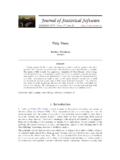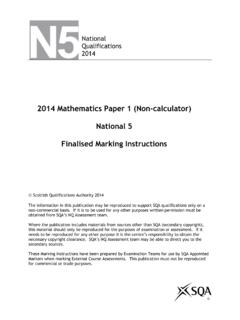Transcription of JournalofStatisticalSoftware - Hadley
1 JSS Journal of Statistical Software MMMMMM YYYY, Volume VV, Issue II. Tidy Data Hadley Wickham RStudio Abstract A huge amount of effort is spent cleaning data to get it ready for analysis, but there has been little research on how to make data cleaning as easy and effective as possible. This paper tackles a small, but important, component of data cleaning: data tidying. Tidy datasets are easy to manipulate, model and visualise, and have a specific structure: each variable is a column, each observation is a row, and each type of observational unit is a table. This framework makes it easy to tidy messy datasets because only a small set of tools are needed to deal with a wide range of un-tidy datasets. This structure also makes it easier to develop tidy tools for data analysis, tools that both input and output tidy datasets. The advantages of a consistent data structure and matching tools are demonstrated with a case study free from mundane data manipulation chores. Keywords: data cleaning, data tidying, relational databases, R.
2 1. Introduction It is often said that 80% of data analysis is spent on the process of cleaning and preparing the data (Dasu and Johnson 2003). Data preparation is not just a first step, but must be repeated many over the course of analysis as new problems come to light or new data is collected. Despite the amount of time it takes, there has been surprisingly little research on how to clean data well. Part of the challenge is the breadth of activities it encompasses: from outlier checking, to date parsing, to missing value imputation. To get a handle on the problem, this paper focusses on a small, but important, aspect of data cleaning that I call data tidying: structuring datasets to facilitate analysis. The principles of tidy data provide a standard way to organise data values within a dataset. A standard makes initial data cleaning easier because you don't need to start from scratch and reinvent the wheel every time. The tidy data standard has been designed to facilitate initial exploration and analysis of the data, and to simplify the development of data analysis tools that work well together.
3 Current tools often require translation. You have to spend time 2 Tidy Data munging the output from one tool so you can input it into another. Tidy datasets and tidy tools work hand in hand to make data analysis easier, allowing you to focus on the interesting domain problem, not on the uninteresting logistics of data. The principles of tidy data are closely tied to those of relational databases and Codd's rela- tional algebra (Codd 1990), but are framed in a language familiar to statisticians. Computer scientists have also contributed much to the study of data cleaning. For example, Laksh- manan, Sadri, and Subramanian (1996) define an extension to SQL to allow it to operate on messy datasets, Raman and Hellerstein (2001) provide a framework for cleaning datasets, and Kandel, Paepcke, Hellerstein, and Heer (2011) develop an interactive tool with a friendly user interface which automatically creates code to clean data. These tools are useful but they are presented in a language foreign to most statisticians, they fail to give much advice on how datasets should be structured, and they lack connections to the tools of data analysis.
4 The development of tidy data has been driven by my experience working with real-world datasets. With few, if any, constraints on their organisation, such datasets are often con- structed in bizarre ways. I have spent countless hours struggling to get such datasets organ- ised in a way that makes data analysis possible, let alone easy. I have also struggled to impart these skills to my students so they could tackle real-world datasets on their own. In the course of these struggles I developed the reshape and reshape2 (Wickham 2007) packages. While I. could intuitively use the tools and teach them through examples, I lacked the framework to make my intuition explicit. This paper provides that framework. It provides a comprehensive philosophy of data : one that underlies my work in the plyr (Wickham 2011) and ggplot2. (Wickham 2009) packages. The paper proceeds as follows. Section 2 begins by defining the three characteristics that make a dataset tidy. Since most real world datasets are not tidy, Section 3 describes the operations needed to make messy datasets tidy, and illustrates the techniques with a range of real examples.
5 Section 4 defines tidy tools, tools that input and output tidy datasets, and discusses how tidy data and tidy tools together can make data analysis easier. These principles are illustrated with a small case study in Section 5. Section 6 concludes with a discussion of what this framework misses and what other approaches might be fruitful to pursue. 2. Defining tidy data Happy families are all alike; every unhappy family is unhappy in its own way Leo Tolstoy Like families, tidy datasets are all alike but every messy dataset is messy in its own way. Tidy datasets provide a standardized way to link the structure of a dataset (its physical layout). with its semantics (its meaning). In this section, I'll provide some standard vocabulary for describing the structure and semantics of a dataset, and then use those definitions to define tidy data. Journal of Statistical Software 3. Data structure Most statistical datasets are rectangular tables made up of rows and columns.
6 The columns are almost always labelled and the rows are sometimes labelled. Table 1 provides some data about an imaginary experiment in a format commonly seen in the wild. The table has two columns and three rows, and both rows and columns are labelled. treatmenta treatmentb John Smith 2. Jane Doe 16 11. Mary Johnson 3 1. Table 1: Typical presentation dataset. There are many ways to structure the same underlying data. Table 2 shows the same data as Table 1, but the rows and columns have been transposed. The data is the same, but the layout is different. Our vocabulary of rows and columns is simply not rich enough to describe why the two tables represent the same data. In addition to appearance, we need a way to describe the underlying semantics, or meaning, of the values displayed in table. John Smith Jane Doe Mary Johnson treatmenta 16 3. treatmentb 2 11 1. Table 2: The same data as in Table 1 but structured differently. Data semantics A dataset is a collection of values, usually either numbers (if quantitative) or strings (if qualitative).
7 Values are organised in two ways. Every value belongs to a variable and an observation. A variable contains all values that measure the same underlying attribute (like height , temperature, duration) across units. An observation contains all values measured on the same unit (like a person, or a day, or a race) across attributes. Table 3 reorganises Table 1 to make the values, variables and obserations more clear. The dataset contains 18 values representing three variables and six observations. The variables are: 1. person, with three possible values (John, Mary, and Jane). 2. treatment, with two possible values (a and b). 3. result, with five or six values depending on how you think of the missing value (-, 16, 3, 2, 11, 1). The experimental design tells us more about the structure of the observations. In this exper- iment, every combination of of person and treatment was measured, a completely crossed design. The experimental design also determines whether or not missing values can be safely 4 Tidy Data dropped.
8 In this experiment, the missing value represents an observation that should have been made, but wasn't, so it's important to keep it. Structural missing values, which represent measurements that can't be made ( , the count of pregnant males) can be safely removed. name trt result John Smith a . Jane Doe a 16. Mary Johnson a 3. John Smith b 2. Jane Doe b 11. Mary Johnson b 1. Table 3: The same data as in Table 1 but with variables in columns and observations in rows. For a given dataset, it's usually easy to figure out what are observations and what are variables, but it is surprisingly difficult to precisely define variables and observations in general. For example, if the columns in the Table 1 were height and weight we would have been happy to call them variables. If the columns were height and width, it would be less clear cut, as we might think of height and width as values of a dimension variable. If the columns were home phone and work phone, we could treat these as two variables, but in a fraud detection environment we might want variables phone number and number type because the use of one phone number for multiple people might suggest fraud.
9 A general rule of thumb is that it is easier to describe functional relationships between variables ( , z is a linear combination of x and y, density is the ratio of weight to volume) than between rows, and it is easier to make comparisons between groups of observations ( , average of group a vs. average of group b) than between groups of columns. In a given analysis, there may be multiple levels of observation. For example, in a trial of new allergy medication we might have three observational types: demographic data collected from each person (age, sex, race), medical data collected from each person on each day (number of sneezes, redness of eyes), and meterological data collected on each day (temperature, pollen count). Tidy data Tidy data is a standard way of mapping the meaning of a dataset to its structure. A dataset is messy or tidy depending on how rows, columns and tables are matched up with observations, variables and types. In tidy data: 1. Each variable forms a column.
10 2. Each observation forms a row. 3. Each type of observational unit forms a table. This is Codd's 3rd normal form (Codd 1990), but with the constraints framed in statistical language, and the focus put on a single dataset rather than the many connected datasets common in relational databases. Messy data is any other other arrangement of the data. Journal of Statistical Software 5. Table 3 is the tidy version of Table 1. Each row represents an observation, the result of one treatment on one person, and each column is a variable. Tidy data makes it easy for an analyst or a computer to extract needed variables because it provides a standard way of structuring a dataset. Compare Table 3 to Table 1: in Table 1. you need to use different strategies to extract different variables. This slows analysis and invites errors. If you consider how many data analysis operations involve all of the values in a variable (every aggregation function), you can see how important it is to extract these values in a simple, standard way.






